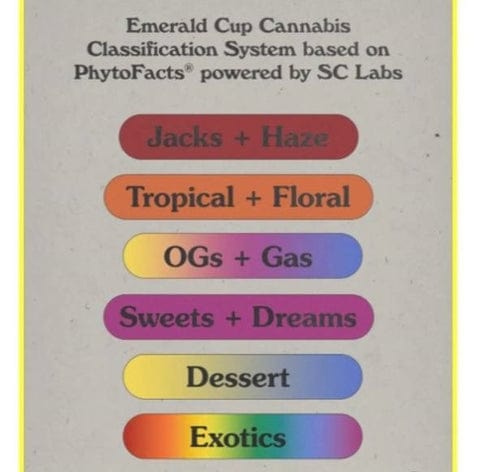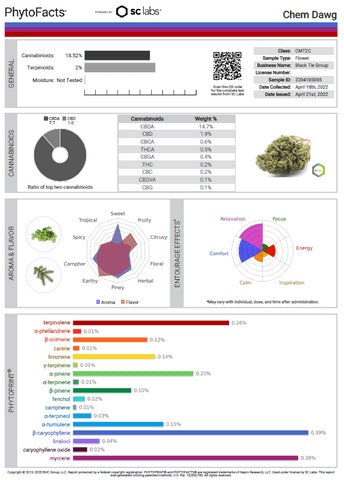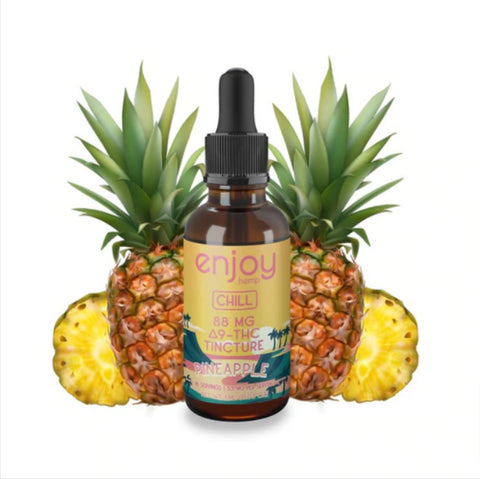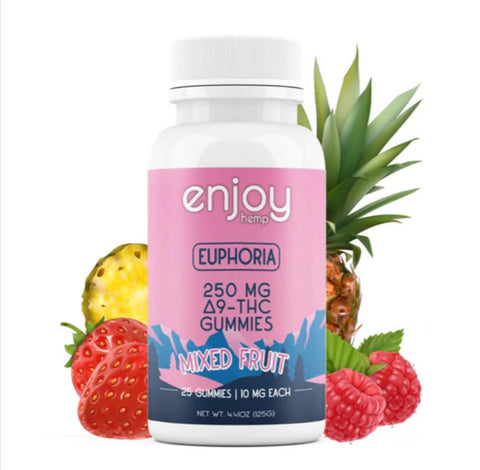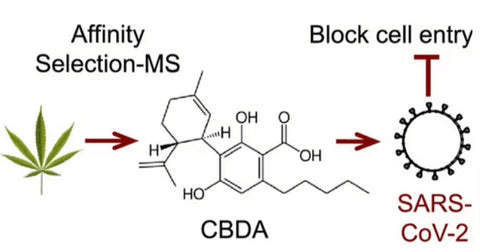Dominant Terpenes In Cannabis
As you may have learned from our last blog, terpenes are the most overlooked yet arguably the most important aspect of cannabis. They’re a little bit like cannabinoids—THC, CBD, and others—in that they have specific and medically useful interactions with our bodies.
If you aren’t familiar with terpenes; unlike cannabinoids, terpenes are found in many plants; they’re the chemicals that give a plant its aroma and flavor. Different levels of terpenes in different strains of cannabis give it a more earthy, fruity, or skunky smell and taste. In addition to stimulating our senses, many of these terpenes have medicinal effects.
In the last several years, scientists started to speculate about the synergic and/or entourage effects of the other cannabis compounds. Today, in the first row are terpenes/terpenoids, but we’re also focused on talking about flavonoids, flavonoid glycosides, and polyphenols. There are 120 terpenes found in cannabis, but for the sake of time, this article will focus on the 5 most dominant terpenes found in cannabis.
So, what are the top 5 terpenes?
One of the most common terpenes found in cannabis is myrcene (also known as alpha-myrcene or beta-myrcene). β-Myrcene is the most common and a particularly potent terpene and is a component of the hydrocarbon fraction of many essential oils. It occurs naturally in over 200 plants and is present in the emissions of many trees in different parts of the world. Exposure to β-myrcene from natural food sources is estimated to be 16,500 times more than from its synthetic use as a flavor substance.
On average, myrcene represents over 20% of the terpene profile in modern commercial strains, although individual samples vary widely in their terpene content.
Scents and Aromas
Myrcene has a spicy, earthy, musky scent that gives cannabis strains a mildly sweet flavor profile. β-Myrcene is a pleasant-smelling, olefinic, acyclic unsubstituted monoterpene that occurs naturally in many plant species, especially in the essential oils of plants such as hops, cannabis, lemongrass, verbena, and bay, as well as in citrus fruits and citrus juices.
Effects of Myrcene
Antioxidant Activity:
In recent decades, there has been growing interest in the use of naturally occurring antioxidants in food preservation. Antioxidant agents are accountable for preventing aging and degenerative diseases such as atherosclerosis, cardiovascular diseases, cancer, diabetes and neurological illnesses. They also have an important role in inhibiting lipid oxidation within food products.
Anti-inflammatory Activity:
Myrcene has shown anti-inflammatory and anticatabolic effects on human chondrocytes. Cartilage degradation and osteoarthritis progression was slowed down. The anti-inflammatory activity of β-myrcene may not only be credited to its antioxidant potential, but also with its interaction with signal pathway cascades involving cytokines and transcription factors.
Central Nervous System Effects and Neurobehavioral Activity:
In a study, Myrcene in cannabis demonstrated measurable effects on the autonomic nervous system in healthy human subjects. Inhalation of cannabis essential oil for 5 min improved nerve activity and was shown to relieve stress and anxiety, and the subjects generally felt more relaxed, energetic, calm, and elevated mood, five min post inhalation.
Black Tie Hemp Strains high in Myrcene:
Strain names commonly classified as indica, sativa, or hybrid can be found with high levels of myrcene, including popular sativa-dominant hybrids like Sour Space Candy and Blue Dream.
Farnesene, also known as Trans-β-farnesene, is a sesquiterpene considered soothing for the mood with calming and sedative effects. Farnesene is an umbrella term for six different sesquiterpenes which are all chemically similar. There are two types of farnesene: alpha (a) and beta (b), both of which are naturally-occurring in a variety of different plants.
Farnesene is an analog of farnesol and is found in various natural sources, including hops, ginger, turmeric, ylang-ylang, and German chamomile. Another intriguing effect of farnesene is that it acts in many plants as a natural insect repellent, functioning as a pheromone that interacts with various insects. Some studies have demonstrated that aphids release farnesene before the danger of death or when dying to warn their companions of the near threat.
Scents and Aromas
The terpene offers a number of notes, including sweet, woody, berry, fruity, and reminiscent of apples. In fact, that is what the smell reminds of - green apple. Whenever you feel these tones when smoking your fine cannabis, that would be Farnesene.
Effects of Farnesene
Antimicrobial Properties
In some studies, farnesene, in conjunction with other terpenes, has shown antimicrobial activity against some serious types of bacteria, such as Staphylococcus subtilis. Even though the research is limited in this area, using the terpene for this advantage in the human body is no doubt fascinating.
Anti-Cariogenic Properties
Certain types of bacteria in the mouth are directly responsible for causing the tooth enamel to break down and deteriorate. Because of the antimicrobial farnesene effects, terpene may help fight tooth decay. The terpene may be active against Lactobacillus acidophilus, one of the common culprits behind tooth decay.
Anti-Inflammatory Properties
Farnesene has been shown to have prominent anti-inflammatory properties. So much so, that the terpene has been used in the past in place of things like ibuprofen to ease everyday discomforts. The anti-inflammatory actions of the terpene may also be important for future studies in its ability to act against allergic responses.
Black Tie Hemp Strains high in Farnesene:
If you’re a grower who appreciates cannabis with a great terpene profile, you may well have heard of beta-Caryophyllene. It is also known as ‘b caryophyllene’, β-caryophyllene or simply caryophyllene. Ever wondered what the difference is between beta caryophyllene and caryophyllene? There is no difference, they are just different names for the same terpene. It was one of the first cannabis-derived compounds other than THC, CBD, and CBN shown to bind directly to endocannabinoid receptors.
It was one of the first cannabis-derived compounds with a fundamentally different structure from the classical cannabinoids that interacts with the endocannabinoid system in humans. In many ways, beta-caryophyllene is an important reminder that terpenes and cannabinoids are not separate and that the two work in conjunction with one another.
Scents and Aromas
β-Caryophyllene is the primary sesquiterpene contributing to the spiciness of black pepper; it is also a major constituent of cloves, hops, rosemary, copaiba, and cannabis. It’s responsible for the slight bite of pungency associated with smelling cracked pepper.
Effects of Caryophyllene
Sleep
In combination with other terpenes, caryophyllene has shown promise as a sedative. A 2012 study published in the journal Pharmaceutical Biology found that mice treated with essential oil containing caryophyllene experienced increased sleep time as well as decreased locomotion and body temperature.
Beta-Caryophyllene Anti-Inflammatory Properties
Beta-caryophyllene can reduce inflammation in the brain and chemicals that cause oxidative stress associated with inflammation. These properties can aid the brain from swelling during a stroke and improve its outcomes. Besides, it has been shown to reduce gut inflammation.
Beta-Caryophyllene Antibacterial & Antimicrobial Properties
Studies suggest that beta-caryophyllene helps fight bacterial dental plaque build-up and is a potential alternative to prescribed medications like chlorhexidine. Also, it reduces microorganisms like Streptococcus pneumonia, Haemophilus influenzae, and E. coli.
Black Tie Hemp Strains high in B-Caryophyllene
This sesquiterpenoid differs from other terpenes because of its unique structure. Guaiol, sometimes referred to as “champacol,” is most abundantly found in oily timber and resin of the tropical guaiacum plant. Moreover, the cypress tree is also known to be rich in this sesquiterpenoid and other conifers. Guaiol differs from many other terpenes—which are oil-based—because of its unique structure as a liquid.
It is a terpene that conveys an aroma of pine that features fragrant undertones of wood and rose. Like other terpenes, this medicinal molecule is produced by many plants other than cannabis, including cypress pine and guaiacum (an evergreen tree of the Caribbean and tropical America).
Scents and Aromas
Guaiol is responsible for the scents of many plants like nutmeg, tea tree, conifers, apples, cumin, and lilacs. It presents a refreshing piney and woody aroma with some undertones of rose in it. For this reason, guaiol is added to a large variety of foods and household items as an aromatic agent.
Effects of Guaiol
Antibacterial Activity:
A 2017 study entitled “The Essential Oil from the Fruits of the Brazilian Spice Xylopia Sericea A. St.-Hil. Presents Expressive In-vitro Antibacterial and Antioxidant Activity” and published in The Journal of Pharmacy and Pharmacology found guaiol to be effective in treating bacterial infections. The research revealed that this terpene may be useful as an antimicrobial ingredient in food preservation.
Cancer Potential:
A 2016 study entitled “Guaiol Regulates RAD51 Stability via Autophagy to Induce Cell Apoptosis in Non-small Cell Lung Cancer” that was published in the journal Oncotarget found that guaiol is an effective agent against cancer cells, resulting in their apoptosis, which is a form of genetically pre-programmed cellular death in which cancer cells basically kill themselves off.
Black Tie Hemp Strains high in Guaiol:
Terpinolene is one of the many terpenes in the terpinene and pinene family. While they all share the same molecular formula, weight, and construction, the placement of the double carbon bond differentiates them. This defines their unique synergistic qualities for therapeutic benefits when combined with CBD products.
Besides showing up in many cannabis varieties, terpinolene is also found in turnips and turpentine. For a long while, research scientists believed terpinolene to act as a sedative. This was due to experiments that determined mice inoculated with terpinolene showed a great reduction in muscle motility contributing to sedation.
Terpinolene by any other name is still terpinolene. Because of its wide use, terpinolene is called by many names depending on the industry and application. Below are a few other names used for terpinolene which you may have encountered in many household products:
- δ-Terpinene (delta-Terpinene)
- 586-62-9 [RN]
- (±)-α-Terpinyl acetate
Scents and Aromas
Terpinolene, though, carries an array of smells you might find in cannabis: It’s piney, floral, herbaceous, and even a little citrusy. Like most other terpenes, terpinolene is produced by various other plant species, including apple, conifer, cumin, lilac, mint, nutmeg, parsnip, and tea tree.
Their extractions from plants are the most important components of the essential oils used in herbal medicine, nutritional supplements, and cosmetics. Terpinolene is used as an aroma agent in soaps and perfumes and as a component of some insect repellents.
Effects of Terpinolene
Sedative
A 2013 study showed sedative effects after nasal absorption into the body(Shimoadachi-cho, 2013). Additionally, In a previous study, the Journal of Natural Medicines tested the sedative effects of terpinolene-dense essential oils on mice. After they isolated terpinolene as one of its active ingredients, they then attempted to determine the structural reason why this terpene has sedative effects. Their research found “Comparison of terpinolene analog activities showed that a double bond in the side-chain or pi bonds in the six-membered ring play important roles in the sedative effect.”
Antimicrobial Activity
One study of a terpinolene-dense plant native to Iran states; “The antimicrobial activity of the essential oil was tested against three different bacteria by disc diffusion method and showed maximum inhibitory activity against Gram-positive bacteria, especially Bacillus subtilis.”
Antioxidant Activity
The International Journal of Phytotherapy and Phytopharmacology published a study where the preparation of LDL from human blood plasma enriched in terpinolene was isolated. The lipids of LDL were protected, and the proteins also didn’t experience oxidation, “This inhibition is due to a retarded oxidation of intrinsic carotenoids of LDL, and not, as in the case of some flavonoids, attributable to a protection of intrinsic alpha-tocopherol.”
Black Tie Hemp Strains High In Terpinolene
From the list of terpenes described, you should see the importance of terpenes in cannabis. They are not merely there for the scents and aromas, but they also have individual medicinal benefits worth considering. Cannabis is so much more than just a strain. Read more about how terpenes are gaining importance here.






